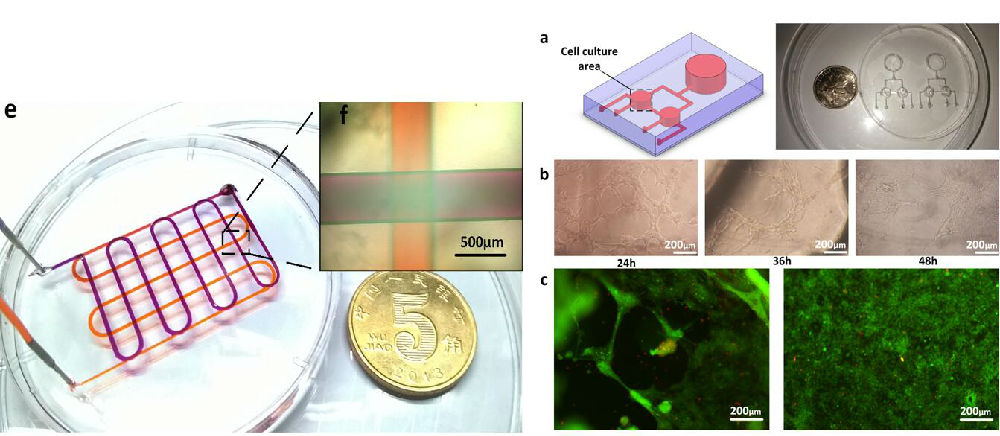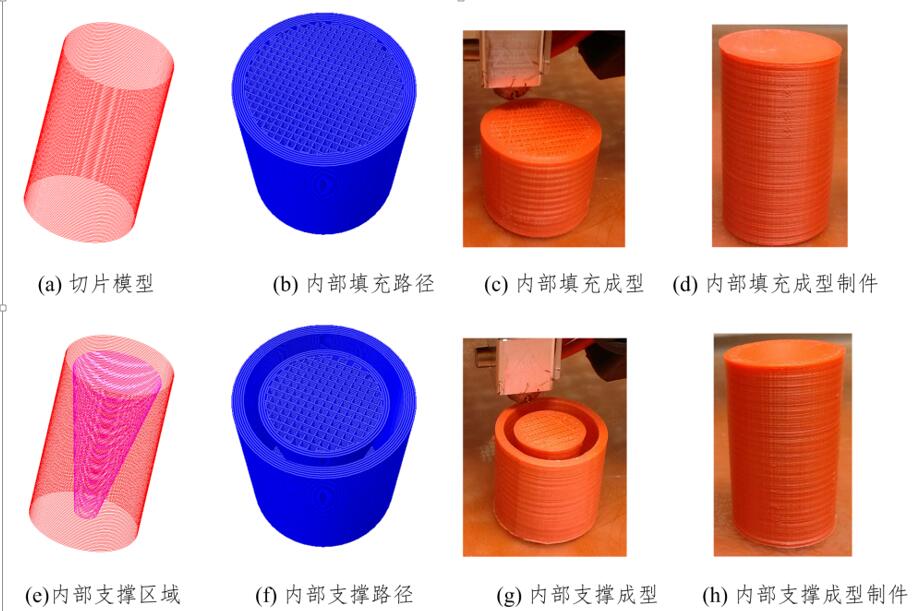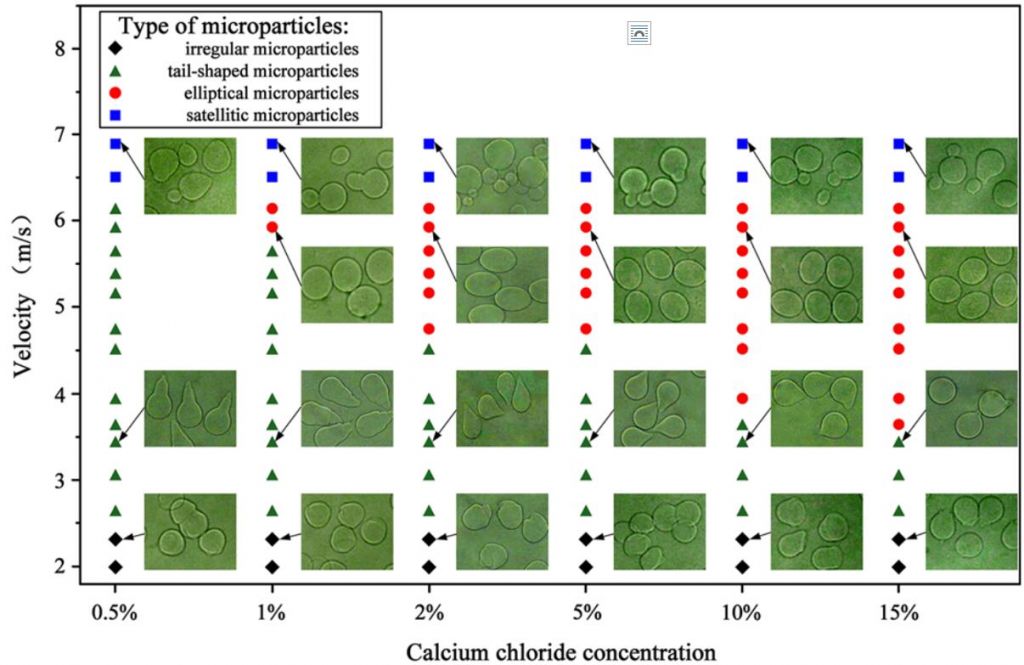博文
器官芯片制造/生物3D打印课题组研究方向简介
 精选
精选
|||
课题组聚焦于制造学科与生物学科交叉领域,尤其是器官芯片制造,期望通过在微流控芯片上构造器官原型(器官芯片),在实验室环境下重现各种疾病的微环境,可广泛应用于药物研发、致病机理研究、细胞发育机制探讨等领域,为生物医学相关学科的研究提供基础支撑。主要围绕三维微流控芯片制造新方法、生物仿生结构3D打印制造新方法、生物3D打印装备的关键技术展开研究。
1、基于牺牲层工艺的微流控芯片制造方法,通过PDMS与牺牲层材料混合打印,能够快速而低成本的构造生物兼容性好的3D微流控芯片,所打印的芯片在细胞立体培养方面具有较大的优势。

2、基于光敏印章印刷方法的微制造方法,将日常生活中常用的光敏印章引入微制造领域,通过多次复合曝光可实现不同尺度微结构的嵌套加工,通过调整曝光掩膜的灰度,可实现不同深度微结构的一次性成型。非常适合于功能微结构的快速制造,可作为软刻蚀及微浇注等工艺的复制模板。

3、基于动态掩膜的微流控纸芯片制造方法,将桌面式3D打印机引入纸芯片的制造中,通过正反面固化,可实现1min内快速制造好一张复杂的纸基微流控芯片。

4、微热压成型技术作为一种低成本微流控芯片制造方法,应用极其广泛。课题组较早的开展了热压成型相关技术研究。建立了压印过程模型、揭示了微压印过程中聚合物流变特性与压印质量及压印效率间的内在关系、提出了模具拓扑优化策略、优化了压印工艺、降低了微热压成型缺陷。
相关论文:
1. He Y, Xiao X, Wu Y, et al. A facile and low-cost microfabrication material: flash foam[J]. ScientificReports, 2015, 5. 13522. (SCI, IF=5.578)
2. He Y, Wu Y,Xiao X, Fu J Z, GuangHuai Xue. A low-cost and rapid microfluidic paper-basedanalytical devices fabrication method: Flash Foam Stamp Lithography [J]. RSC Advances, 2014, 4(109):63860-63865. (SCI,IF=3.84)
3. He Y, Wu Y,Xiao X, Fu J Z*et al. Fabrication of Paper-BasedMicrofluidic Analysis Devices: a Review[J]. RSC Advances, 2015, 5(4),78109-78127 (SCI, IF=3.84)
4. He Y, Wu W B,Fu J Z. Rapid fabrication of paper-based microfluidic analytical devices withdesktop stereolithography 3D printer [J]. RSCAdvances, 2015, 5(4), 2694-2701. (SCI, IF=3.84)
5. He Y, Qiu J J, Fu J Z, Zhang J et al. Printing 3D microfluidic chip with a sugar 3D printer[J]. Microfluidics and Nanofluidics, 2015,19, 447-456. (SCI, IF=2.528)
6. He Y, Fu J Z, Chen Z C.Research on optimization of the hot embossing process[J]. Journal ofMicromechanics and Microengineering, 2007, 17(12): 2420. (SCI, IF=1.7)
7. He Y, Fu J Z, Chen Z C.Optimization of control parameters in micro hot embossing[J]. MicrosystemTechnologies, 2008, 14(3): 325-329. (SCI, IF=0.875)
8. He Y, Wu W B, Zhang T, et al.Micro structure fabrication with a simplified hot embossing method[J]. RSCAdvances, 2015, 5(49): 39138-39144. (SCI, IF=3.84)
9. He Y, Fu J Z, Zhao P, et al.Enhanced polymer filling and uniform shrinkage of polymer and mold in a hotembossing process[J]. Polymer Engineering & Science, 2013, 53(6):1314-1320. (SCI,IF=1.52)
10. He Y, Fu J Z, Chen Z C. Analysis of pattern height development inhot embossing process[J]. Microsystem technologies, 2009, 15(7): 963-968. (SCI)
11. He Y, Fu J Z, Chen Z C. Experimental study on the hot embossingpolymer microfluidic chip[J]. Chinese Journal of Mechanical Engineering, 2008,21(3): 87-89. (SCI, IF=0.598)
12. He Y, Zhang T, Fu J Z, et al. Experimental Study on theFabrication of the Light Guide Plate with Hot Embossing Method[C]//AppliedMechanics and Materials. 2010, 37: 448-452.
1、基于营养通道同步构造的细胞打印新工艺,证实了本工艺所构造的微通道能够有效的用于组织内的营养输送,可起到类血管的作用;给出了打印过程中融合机理及融合时序,系统的探讨了可打印工艺区间;通过调控相邻凝胶微通道间的融合时序,可实现组织打印过程中的三维微流道网络的构建,为大尺寸器官打印中的营养输送难题提供一条可行的路径。

2、假体已经广泛应用于人体颌面部损伤的修复中,传统个性化定制假体周期长,价格昂贵,严重制约了其在临床上的应用推广。课题组提出了一种3D打印低成本假体制造方法,利用桌面级3D打印技术的低成本,通过抛光技术去除掉打印模具的台阶效应,制造出表面粗糙度Ra低于1μm的光滑模具,浇铸出具有光洁表面的人工假体,使其成本从4000美元/件降至30美元/件。

发表的论文
1. Qing Gao, Yong He*,Jian-zhong Fu, An Liu, Liang Ma. Coaxial nozzle-assisted 3D bioprinting withbuilt-in microchannels for nutrients delivery[J]. Biomaterials, 2015, 61, 203-215. (SCI, IF=8.557)
2. He Y, Xue G H,Fu J Z, Fabrication of low cost soft tissue prostheses with the desktop 3Dprinter [J]. Scientific Reports,2014, 4, 6973. (SCI, IF=5.578)
3. Shao H, Yang X, He Y*, et al. Bioactive glass-reinforced bioceramic ink writingscaffolds: sintering, microstructure and mechanical behavior[J]. Biofabrication, 2015, 7(3): 035010. (SCI, IF=4.289)
4. Xie J, Yang X, Shao H, HeY, et al. Simultaneous mechanical property and biodegradation improvementof wollastonite bioceramic through magnesium dilute doping[J]. Journal of the mechanical behavior ofbiomedical materials, 2016, 54: 60-71. (SCI, IF=3.417)
课题组对芯片3D打印及细胞打印装备研发过程中所涉及的相关核心技术,包括表面粗糙度改进、速度平滑控制、快速支撑生成算法、打印误差控制与补偿等进行了系统的研究,研发了具有自主知识产权的细胞打印及芯片打印装备。
1. 为解决打印过程中的过填充与欠填充问题,通过采用自适应间距路径避免恒定间距路径填充过程中出现的质量问题,提高了打印质量。为提高打印过程中的支撑生成算法效率及稳定性,通过采用切片文件而非三维实体模型实现支撑区域的判断,可避免大量的三维布尔运算,提高了算法的运算效率。为提高制造加工的效率,提出内支撑的概念,可直接利用切片文件实现内支撑生成算法。

2. 针对细胞打印中凝胶的可控沉积问题进行了深入研究,通过分析加工速度及加工路径对液滴沉积偏转的影响,建立了误差补偿模型。揭示了5种构造不同形态规律凝胶微球的成型机制,系统的阐述了其成型机理,实现了含细胞凝胶液滴的可控沉积。

3. 针对3D打印过程中零散线段过多,导致加工效率过低的问题。提出并实现了基于改进精插补的参数曲线插补算法,使精插补过程中加工误差最小化,并且使进给速度曲线更加平滑。在粗插补过程中根据当前的进给速度确定前瞻路径长度,在搜索到危险区域之后通过反算确定减速点的位置,该算法可以提高参数曲线插补精度和加工过程的平稳性。

发表的论文
1. JinY, He Y*, Gao Q, et al. Droplet deviationmodeling and compensation scheme of inkjet printing [J]. The InternationalJournal of Advanced Manufacturing Technology, 2014, 75(9): 1405-1415. (SCI, IF=1.458)
2. Jin Y A,He Y*, Xue G H, et al. Aparallel-based path generation method for fused deposition modeling [J]. The International Journal of AdvancedManufacturing Technology, 2015, 77(5): 927-937. (SCI,IF=1.458)
3. Jin Y A, He Y*, Fu J Z. Support generation for additivemanufacturing based on sliced data[J].The International Journal of AdvancedManufacturing Technology, 2015, 80(9), 2041-2052 (SCI, IF=1.458)
4. Gao Q, He Y*, Fu J, et al. Fabrication ofshape controllable alginate microparticles based on drop-on-demand jetting[J]. Journal of Sol-Gel Science and Technology,2015: DOI: 10.1007/s10971-015-3890-2. (SCI, IF=1.532)
5. Jin Y A,He Y*, Fu J Z, et al. A fine-interpolation-basedparametric interpolation method with a novel real-time look-ahead algorithm[J]. Computer-Aided Design, 2014,55: 37-48. (SCI,IF=1.801)
6. JinY, He Y*, Fu J. A look-ahead and adaptive speed control algorithm forparametric interpolation [J]. The International Journal of AdvancedManufacturing Technology, 2013, 69(9-12): 2613-2620. (SCI, IF=1.458)
7. JinY A, He Y*, Fu J Z, et al. An interpolation method for the open CNCsystem based on EPM [J]. The International Journal of Advanced ManufacturingTechnology, 2013, 69(1-4): 405-416. (SCI,IF=1.458)
8. Jin Y, Li H, He Y*, et al. Quantitative analysis of surface profile in fused depositionmodeling[J]. Additive Manufacturing,2015, 8: 142-148.
9. JinY, He Y*, Fu J, et al. Optimization oftool-path generation for material extrusion-based additive manufacturingtechnology [J]. Additive Manufacturing, 2014, 1(1), 32-47.
https://blog.sciencenet.cn/blog-2159320-948630.html
上一篇:招收生物或医学背景的博士后 浙江大学三维打印省重点实验室
下一篇:3D打印微流控芯片及其在化学、生物中的应用进展综述